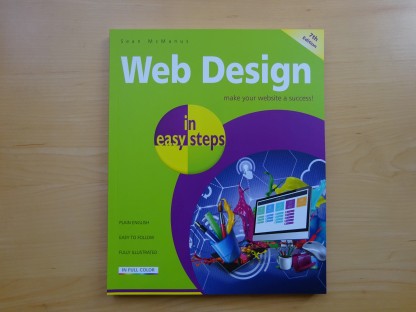
Coding Compendium
A free 100-page ebook collecting my projects and tutorials for Raspberry Pi, micro:bit, Scratch and Python. Simply join my newsletter to download it.
Internet Works, October 2004
It's a great business opportunity and it's a legal obligation so making your website accessible to people with disabilities should be a priority. By Sean McManus.
People with disabilities have an annual spending power of £50 billion according to the Disability Rights Commission (DRC), but most websites are locking them out. The DRC tested 1000 websites and found only 19% of them met the most basic accessibility requirements.

A partially-sighted person using the web with screen magnification and a large print keyboard. Photo courtesy RNIB.
Since 1999, those providing a service online have been obliged under the Disability Discrimination Act (DDA) to make reasonable adjustments to ensure their website is not unreasonably hard for people with a disability to use.
Last year the Royal National Institute for the Blind (RNIB) initiated legal action against two websites on behalf of two of its members. Both cases were settled out of court and concluded with confidentiality clauses. "RNIB doesn't cherry pick cases to take," says RNIB digital policy development manager Julie Howell. "Rather, when approached by a visually impaired person wishing to take a case under the DDA, where we decide that discrimination has occurred under the terms of the Act, RNIB can and will use the law as an instrument for asserting the rights of the visually disabled person concerned."
Research by Forrester commissioned by Microsoft concluded that 57% of adult computer users could benefit from accessible technology. "The research results were surprising initially, but we knew they could help dispel the traditional idea that people fall into only two categories: those with disabilities and those without," says Madelyn Bryant McIntire, director of Microsoft's accessible technology group. "There are millions of people along the continuum of human ability for whom accessible technology can make a difference."
Previously, only companies with 15 staff or more had to abide by the DDA when recruiting staff. From October, that threshold disappears, which means businesses could find the accessibility of their intranets comes under the same scrutiny as their public websites.
Blind people often use screenreader software which reads the content of a website aloud. Download a trial version of screenreader Jaws. Switch off your screen, and try using your website. It's also helpful to use text-only browser Lynx to see what's left when the graphics, colours, sound and rich media are stripped from your site. It's not the same experience people using assistive technology have at your site, but it often flags up major problems.
You can't abdicate your duties under the DDA to your design agency, so swot up on the Web Accessibility Initiative (WAI)'s web content accessibility guidelines. They explain checks website designers should perform to make sure a site is accessible. They are graded as A, AA or AAA. Level A guidelines represent the minimum standard a website should meet, but most sites should aspire to at least AA.
There's a free online checker [link no longer available] (formerly known as Bobby) which will check your site against the WAI guidelines. The detailed report can be daunting, but can quickly identify obvious faults such as missing descriptive text for images.
Julie Howell says Bobby reports can be helpful in highlighting a potential DDA liability to senior management: "Automated tests are useful for selling the idea at board level. There's nothing like a detailed report output by a web accessibility test to put the frighteners on people."
Interpreting Bobby's reports can be hard work, so consider getting specialist help. Deri Jones, CEO of web application testing company SciVisum, says: "Unless you already have a good accessibility background and knowledge of the technical issues underlying the area, it's best to call in accessibility test specialists to provide an engineered test of your whole site, and to report back the issues. This will be quicker than a DIY approach and usually cheaper too once the costs of the internal time resources are included."
The Disability Rights Commission conducted usability testing with 50 people with differing access needs. They found that 45% of the problems reported by the users weren't covered by a WAI checkpoint and the most important checkpoints were qualitative and couldn't be decisively tested automatically.
"You can get Bobby accreditation but the reality is your site could be hard to use," says The Usability Company director Marty Carroll. "We conduct tests with disabled people using their own computer configurations, sometimes in their own homes."
Julie Howell adds: "City University has suggested that if you only do testing with people with disabilities, not only will they find all the problems specific to their needs but because they are people, they will pick up on all usability problems. It's an untested but interesting idea."
"We hired a design agency partly because they said they understood accessibility," says one manager of a website worth over £40,000, who requested anonymity. "They didn't really and certainly weren't committed to it- I'd point out accessibility problems and they would say 'yes, but how many of your visitors are blind anyway?'"
"It's important to realise that the automated tests can be fooled with a bit of ingenuity, so an unscrupulous agency can deliver you a site which 'ticks all the boxes' but doesn't actually give you - or more importantly your users - any additional value," says Matt Connolly, communications director at design agency Enable Interactive. "Quiz the agency on their understanding of the real issues faced by disabled users. Ask them about what they do over and above Bobby. Do they test their designs with disabled users or have any dialogue with the groups that support them?"
Wherever possible, hire users of assistive technology, even if only part time. Kara Pernice Coyne, director of research at Nielsen Norman Group, says: "Several years ago when I worked on Lotus Notes, we hired a person who is blind and who uses a screenreader. We saw the issues first-hand and had a wonderful resource available all the time. Most importantly, knowing the person gave the accessibility issues a more human angle, which made the team even more receptive to fixing the issues."
While Manchester United and Tesco have created separate accessible sites, most businesses can't commit the resources needed to run two websites effectively. If the accessible site contains less information than the main site, users feel slighted.
Coyne says: "Even if there is a text-only site, users feel that it may not present all the information or the same information as the main site. These users are often right as many text-only sites provide pared down information. Even if the sites do have the same information, it is still an issue that the users feel the sites might be different."
Update: Both Manchester United and Tesco have subsequently abandoned their strategy of creating a separate accessible site.
Make sure your site responds to browser controls to increase the font size and consider providing instructions or embedding your own font controls in your webpage. "Not all users who would benefit from these controls know how to use them and many do not even know they exist," says Donna North, head of creative production Europe at TWI Interactive which built the Manchester United accessible site. "Font size controls within the page are seen as very useful, and the possibility to change the site colour scheme but still retain the branding and identity of the site is well received."
Use stylesheets to separate your design from your structurally marked-up content.
"Someone with extremely poor vision might need a black background with brilliant yellow text," says Trenton Moss, MD of design consultancy Webcredible. "A dyslexic might find it easier to read using the Comic Sans font. They can program in their own stylesheets, which override yours. They can't, though, override any formatting effects you put in the HTML."
Make sure your design is consistent from page to page. Léonie Watson works as accessibility consultant at Nomensa and is a screenreader user. She says: "Consistency is important for users who are not able to take in the entire page at a glance. As a screenreader user becomes familiar with a site there is an expectation that elements will be located at the same point on every page. This speeds up the process of moving through a web site both for sighted and non sighted users."
"Try to refrain from using images for navigational links," says Watson. "For users with minor visual impairment (not sufficient to require a screenreader or magnifier) reading images can be very difficult, particularly if the font is small or elaborate. Because the images cannot be resized it is quite possible the link will become inaccessible." She recommends text in navigation buttons is in a clean font at 16 point if it can't be enlarged.
Provide a 'skip navbar' link so screenreader users don't have to listen to the same list of links before getting into your content on each page.
Assistive software can summarise webpages by looking at the headings and links. Structure your information using heading tags and make sure links make sense out of context and uniquely describe their destination. Don't have links that say 'click here' or 'more'.
Don't let people updating your site spoil it by adding images with meaningless descriptions or links that say 'click here'. Train your site editors so they understand how to create accessible content.
Publish an accessibility statement on your site, outlining what measures you have taken to make your site accessible and any known problems.
The statement can also demonstrate the company's commitment to accessibility and invite feedback on improving accessibility. Watson says: "If an organisation has aimed at Level AAA compliance against the WCAG, but finds that one or two minor checkpoints are difficult to meet, an accessibility statement can be a good place to outline this and to explain to the user the justification for not reaching their intended goal."
Make regular accessibility testing part of your ongoing site maintenance programme. Jones recommends that companies allocate between 8% and 13% of their online presence costs for ongoing testing. This maintenance budget should be used to monitor key performance indicators, conduct stress tests twice a year to check the system can cope with peaks in demand and test usability as well as twice yearly accessibility testing. Smaller companies could focus one of the tests on changes that have been made to the website.
Retrofitting accessibility to a site is much more expensive and complicated procedure than building an accessible site from scratch, where the marginal cost should not be significant. If you have a site already, start by planning the transition. "No matter what you choose to do first, start small," says Coyne. "In many cases if the accessibility initiative does not yet have the support it needs, then a colossal initiative will likely fail. Consider taking a more subtle approach, small steps, and involve others. Soon you will be able to show improvement, and the word will spread."
The DRC found that just eight checkpoints in the WAI guidelines accounted for 82% of the reported problems. Those checkpoints require websites to:
"Accessibility is not about dumbing down, stifling creativity or constraining innovation. Quite the contrary. Designers have a privileged position to increase accessibility by offering new ways of interacting with content," says John Knight, usability engineer at non-profit usability research organisation User-Lab.
© Sean McManus. All rights reserved.
Visit www.sean.co.uk for free chapters from Sean's coding books (including Mission Python, Scratch Programming in Easy Steps and Coder Academy) and more!

A free 100-page ebook collecting my projects and tutorials for Raspberry Pi, micro:bit, Scratch and Python. Simply join my newsletter to download it.

Web Design in Easy Steps, now in its 7th Edition, shows you how to make effective websites that work on any device.

Power up your Microsoft Excel skills with this powerful pocket-sized book of tips that will save you time and help you learn more from your spreadsheets.

This book, now fully updated for Scratch 3, will take you from the basics of the Scratch language into the depths of its more advanced features. A great way to start programming.

Code a space adventure game in this Python programming book published by No Starch Press.

Discover how to make 3D games, create mazes, build a drum machine, make a game with cartoon animals and more!